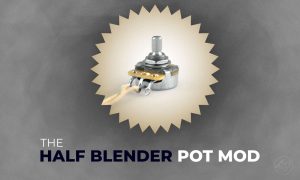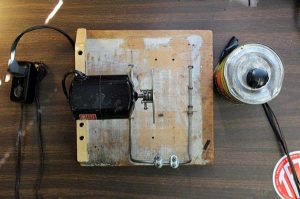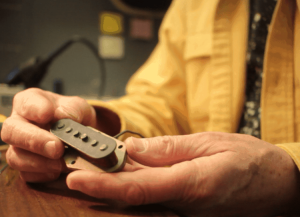
How To Use A Multimeter with Guitar Pickups
The Multimeter is one of our most-used tools in our workshop. It’s used to test pickup continuity, phase, and resistance of our pickups. Within a few seconds, we can test a pickup to determine what might be wrong with the pickup. Let’s talk about how we use our Multimeters, and how you can use this powerful tool correctly!
The Basics of Using a Multimeter With Your Guitar:
Once you understand the basics of using a multimeter, you won’t look back. The multimeter is one of those tools that gives you a super power: see the flow of electricity and diagnose wiring issues. With a multimeter, you can:
- Check if a guitar pickup is healthy or not by reading it’s resistance
- Find a short by finding where the signal is broken
- Diagnose ground issues by finding what part of your guitar isn’t grounded properly
- Check the phase of a guitar or bass pickup
What setting Do I Use?
The Multimeter comes with a wide variety of settings out of the box, and while it’s main use is for home electrical tasks (like checking to make sure an outlet is healthy), there are other features that work really well for the guitarist or musician:
- AC Voltage: You can use this setting to test Wall Current, not really applicable to the guitar, but could be helpful if diagnosing power issues in your home or studio.
- DC Voltage: Test a battery to see if it’s good or not! Very handy to have if you have a lot of guitar pedals, or you’re just not sure if that battery in your gig bag is actually a good one.
- Resistance (Ohms): Our most-used setting. Test a wide array of issues and get the shortcut to your problem quickly!
- Continuity: Can be helpful, but doesn’t give you as much information as Resistance.
Digital Or Analog?
Either style of multimeter will work, but if you’re a serious bench tech, it’s a good idea to have both, as both have their strengths and weaknesses:
- Analog: Analog, or what we call a “Needle Meter”. It’s a great way to quickly check resistance, but we use it all the time to check the phase of a pickup (More on this below). If you opt for an Analog meter, be sure to “zero” your meter first. See below on how to do this:
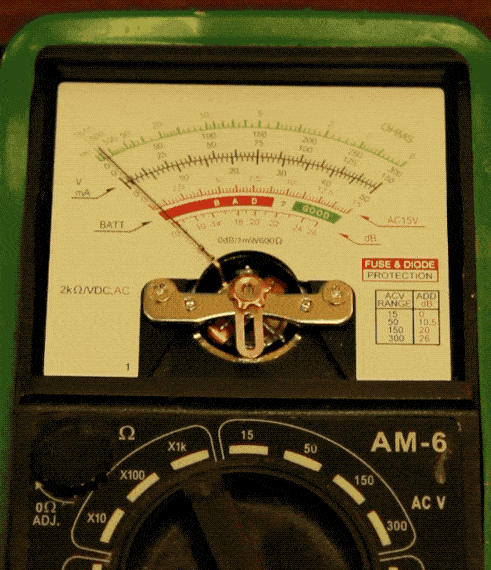
- Digital: Digital Meters are probably the most readily available and most useful meters. There are some things that are more difficult to do with a Digital Meter. However, it offers the most accurate Resistance readings out there, and they require no calibration.
What Can you Do With A Multimeter?
Checking The Resistance:
Resistance is a term for measuring the difficulty to pass an electrical current through a wire or circuit. We use this all the time, and there’s a lot we can learn from measuring the Resistance of a guitar pickup. We use this setting to test if a guitar pickup is healthy, comparing two pickups, diagnosing problems, and testing the continuity of a circuit.
Checking the Continuity With Resistance: If you get an Ohm reading from a guitar pickup, it has continuity. You’ll get an Ohm reading, showing that the electricity is going from Point A to B, which is Hot to Ground.

Testing Continuity
Continuity is the flow of electricity through a circuit. If a circuit has Continuity, electricity can get from point A to point B. If a circuit doesn’t have Continuity, there’s a break somewhere in the signal path. We use continuity to test grounding issues, and testing whole circuits on a guitar.
There are a few ways to test Continuity. Most new digital meters have a Continuity feature, and you’ll hear an audible “beep” when the circuit closes (that setting won’t work for guitar pickups). If you don’t have a Continuity feature on your meter, you can test continuity using the Resistance setting.
Continuity Readings
See the two images below on how to determine if the connection is healthy of not:

Using the Resistance setting, you can see that the circuit is healthy when there’s no resistance. Basically, electricity is freely flowing from point A to B.
Real World Example: Let’s say you’re trying to hunt down a grounding issue in your guitar. By touching one of the terminals to a common ground (the back of the volume pot, for example), you can use the other terminal to see which other part of the guitar isn’t grounded. You should see a “0.0”, or close to “0” as possible, to see that there is a healthy connection with ground. If you see a “0.L”, you know there’s a break somewhere in the signal path and that’s the item that needs to be grounded.
Checking The Phase (Needle Meter):
Testing the phase of a pickup is a great way to see which way the pickup “Meters”. We use this all the time when doing install work. It’s a quick way to determine if a new pickup will be in phase with your other pickups or not. Here’s how you do it:
- Set your Meter to measure Resistance.
- Attach your Red Wire to the Hot of the guitar pickup
- Attach your Black Wire to the Ground of the guitar pickup (you should have an ohm reading now)
- Use a Steel Item (screwdriver / pair of pliers) to touch the magnets and observe what happens to the needle when you pull away the Steel.

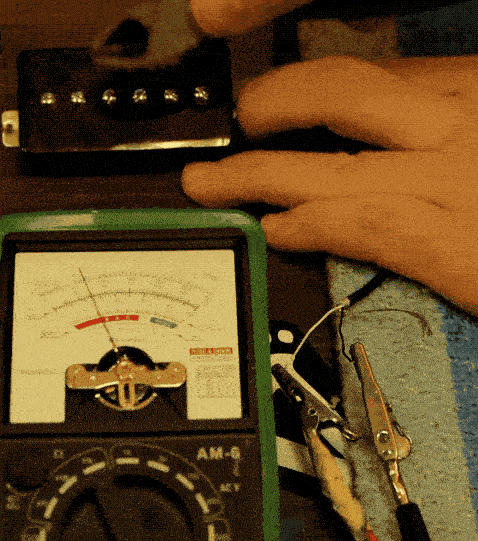
The above gif has a pickup that meters down. When we pull the steel away from the pickup’s magnetic field, the needle is pulled towards 0 Ohms.
If you wanted to reverse the phase: You could swap the leads. Reversing the White and Black leads from the pickup will make this pickup Meter Up.
Real-World Example: Let’s say you just bought a pickup with multiple leads, like the 2-Conductor seen above. You’re about to install it in your guitar that already has a pickup installed. You can take a Phase check of both pickups to see how you wanted to wire the new pickup. If your original pickup meters up, and your new pickup meters down, reverse White and Black to reverse the phase.
Well, that’s about it for now. We use these handy multimeters all the time when diagnosing and checking our guitar pickups, and you should too! Let us know if you have any other questions!


